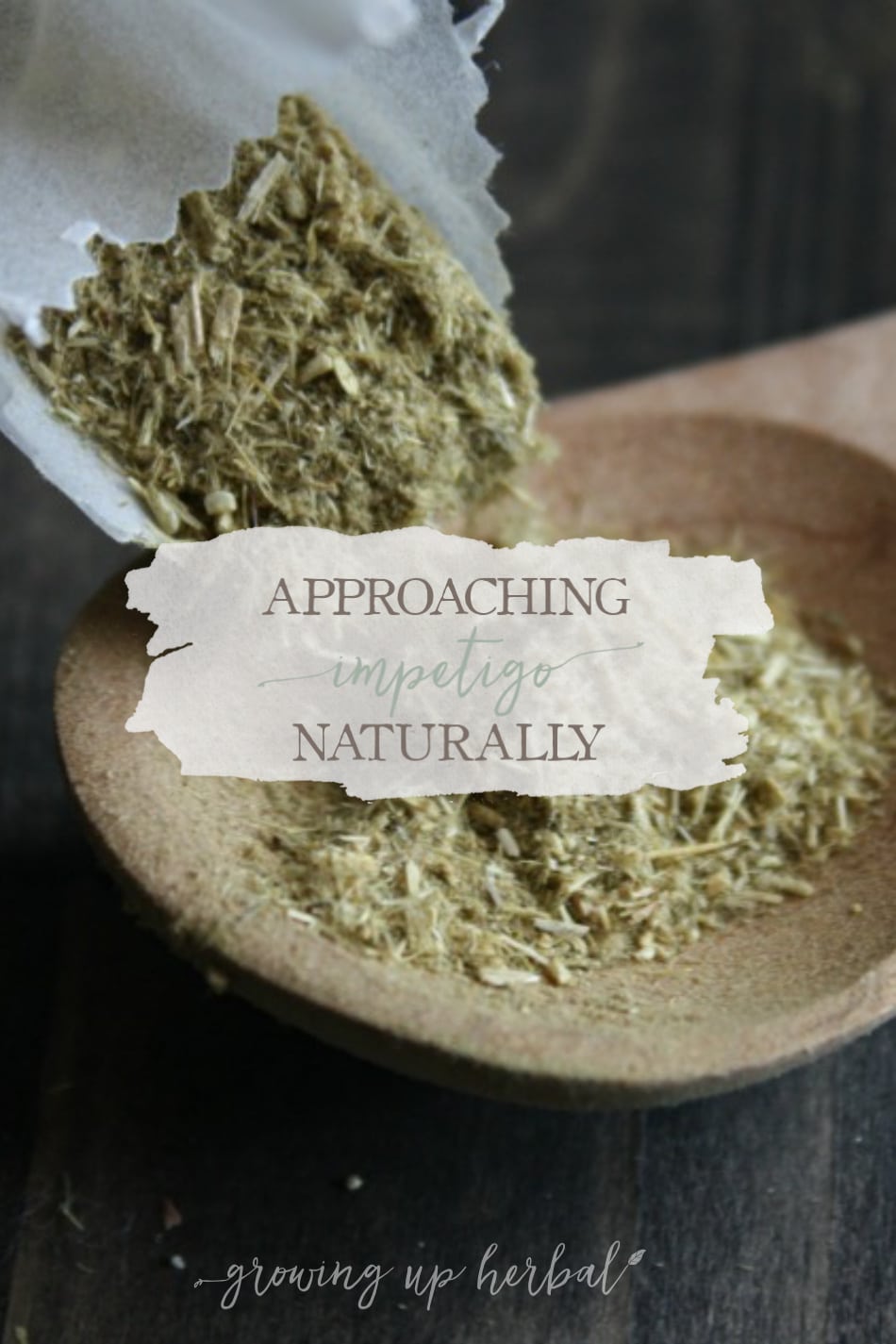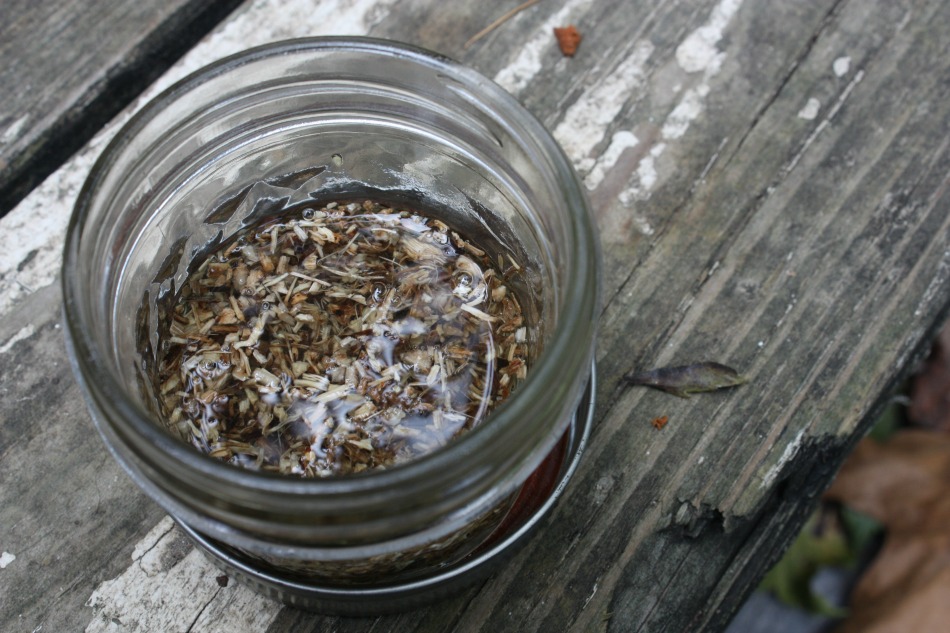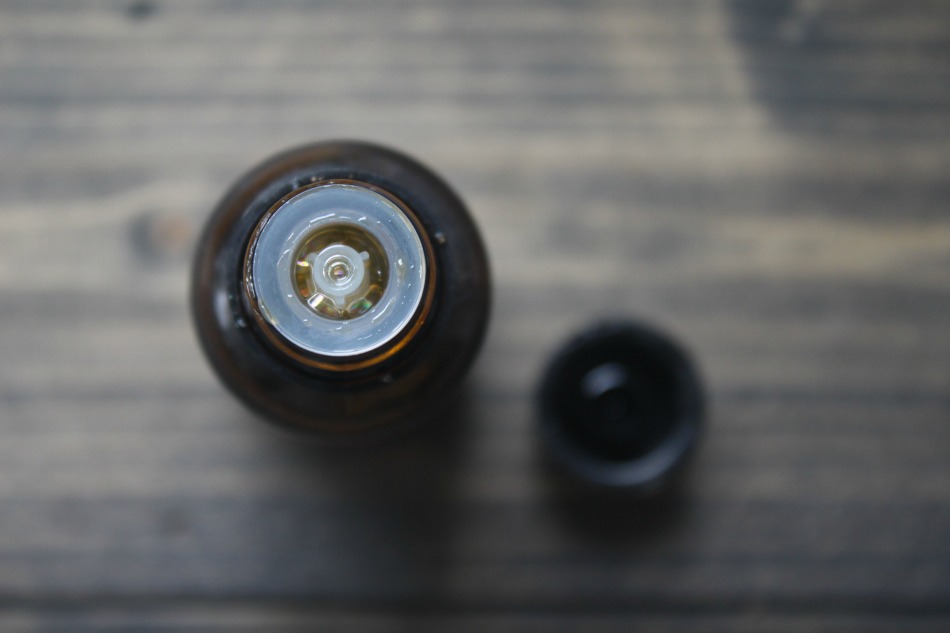
Several months ago, my then six-year-old came down with a case of impetigo. I’d heard about impetigo before, but it wasn’t something I was too familiar with. I mean, I’ve never seen anyone with it before, and I don’t think it’s something that is all that common in our local area. Nevertheless, in an effort to do things as naturally as possible, we approached the situation from a natural perspective.
Today, I’d like to tell you about it in case you find yourself approaching impetigo naturally at some point. Hopefully, our story will be helpful to you.
A Cat Scratch or Spider Bite??

The last week of October, we took home the sweetest stray cat. She was very friendly, but she was skinny and had fleas. And while I’m not much of a cat person, each of the boys has his own cat, except the youngest, and he wanted to make this cat his own so badly. So, of course, I said yes. I mean, what’s one more cat when you already have three, right? (If I turn out to be a crazy cat lady in my old age, tell my children it was their fault!)
Turns out, the cat is deaf. She’s solid white and has heterochromia (two different colored eyes). This is a genetic issue, and deafness often accompanies it. She’s adapted well, but she scares easily. During the first week of having her, we learned to make ourselves known by walking harder across the floor or touching something next to her so she could feel the vibrations. We also learned to turn the lights off or on to get her attention as well. At first, the boys forgot, especially the younger two. They would run up to her, scare her, and sometimes get scratched. Nothing major. Just a small scratch here and there.
Then, one morning in early November, my six-year-old, Uriah, came to me saying his wrist was hurting. He had a large red spot with an infected looking center. It looked exactly like a nasty spider bite, and I was concerned something venomous had bitten him. We have some nasty looking wolf spiders around our home. (Shudder!) So I did some quick research on spider bites, decided to put some black drawing salve on it (recipe here), and watch it for a day or two to see if it got better or worse. If it got worse, we may need to head to the doctor.
Over the course of the next several days, not only did the spot not respond to the black drawing salve, but it got worse and more spots started to develop. At this point, I knew this wasn’t a spider bite but something else so back to Google, I went.
Hello, Impetigo!
Through my search, I found impetigo which is apparently a very common skin infection, especially among children. How have I not seen this before?!
According to Web MD, impetigo is a superficial skin infection caused by strep (Group A Streptococcus) and staph (Staphylococcus aureus) bacteria (WebMD, n.d.b.). It’s very contagious and easily spreads from person to person when the wounds are in their weepy stage. Most lesions start as small, itchy spots on the skin, begin to ooze (spreading the bacteria to other sites), crust over with honey-colored scabs, and eventually dry out and go away. They can show up anywhere on the body, but they tend to be clustered together in groups. In most cases, impetigo isn’t dangerous. With topical antibiotic treatment, it goes away in around 10 days. Left alone, it goes away in 14-21 days. In severe cases, it can lead to worse health conditions like cellulitis among other things. People with impetigo generally feel well and don’t have fevers or other symptoms. However, the lesions may itch or be painful.
Uriah was my first child to need emergency antibiotics, you guessed it, for cellulitis (also commonly caused by staph) when he was 18-months-old. He was hospitalized for a couple of days but recovered nicely. Since then, he’s occasionally had a few small bumps form on him that looked like they could be the beginning of a boil. I’ve immediately resorted to black drawing salve and lavender essential oil, and these have always gone away.
In this case, I’m guessing the cat scratched Uriah and either the bacteria on his skin or from the cat’s nail infected the wound site. Normally, the boys tell me if they get a cut or scratch so we can wash it, apply some antibacterial salve, and bandage it (I’m a big stickler for this now after the cellulitis incident), but in this case, he didn’t tell me.
A Staph Carrier?
During my research for impetigo, I found that it’s believed that 30% of people are staph carriers — someone who has staph colonized on their body (Schweizer & Herwaldt, n.d.). Being a staph carrier is believed to make a person more susceptible to acquiring a staph infection, but it’s also suspected that the infections aren’t as severe in staph carriers as they are in persons that are not carriers. This is thought to be due to carriers having a more active immune response or to lower virulence of the staph strains in carriers (Schweizer & Herwaldt, n.d.).
I’ve always wondered if Uriah was a “staph carrier,” and while he is my only child who’s ever come down with staph-related infections, I know this doesn’t guarantee that he’s a carrier. I’d have to have him tested to see if he were.
Decisions, Decisions — Medications or Herbs?
With every ailment we face, there are decisions to be made. I have to ask myself, “Is this something I can approach naturally with the help of lifestyle changes and herbal supplements, or is this out of my league, and therefore, needs a doctor’s attention?”
Thankfully, most times, I feel knowledgeable and equipped enough to handle things here at home, but it’s taken time and experience to get to this place. In this case, after much research, I decided that there were things I could do for him here at home, and if he got worse, then we’d go to the doctor.
This is my normal response to sicknesses in our home. I do what I can to approach each situation from a natural perspective, but if the body doesn’t respond and things don’t improve or get worse, we seek further help from our doctor and the medications he/she can offer. I feel that this is a very rational approach.
Approaching Impetigo Naturally
Below, I want to share how I handled approaching impetigo naturally — successes, failures, and things I’m not so sure about. My goal here is to document this for you in case you find yourself approaching impetigo naturally at some point. This information can also be helpful for anyone looking to approach any health condition from a natural perspective.
#1: Know Your Enemy
The most important part of approaching impetigo naturally is to first know what you’re facing.
Impetigo is caused by strep (Group A Streptococcus) or staph (Staphylococcus aureus) bacteria, so I needed to do some research to learn about these bacteria (how they spread, how modern medicine deals with them, so on and so forth) and to find which herbs have been traditionally used as well as which herbs and essential oils have been shown to inhibit or reduce these two bacteria on the skin in modern scientific studies.
Since I was fairly positive this was a staph infection, I did the most research on it. Staph is a gram-positive bacteria, and its severity depends on the strength of the infection, how deep it goes into the tissues, how fast it spreads, and how treatable it is with antibiotics (WebMD, n.d.a.). Staph infections are commonly treated with strong antibiotics, and oftentimes, they’re very resistant to them.
#2: Prevent Further Contamination
The second most important part of approaching impetigo naturally is to prevent it from spreading, and this is tough, especially with little kids! When the lesions are leaking or weeping, the infection can spread to other parts of the body. Normally, healthy skin isn’t affected, but if there’s an area with a cut or scrape, it can become infected which leads to further impetigo lesions.
To prevent contamination between Uriah and the rest of us, the first thing I did was to sit everyone down and explain what was going on. I told the brothers that Uriah had a common skin infection, that it was very contagious, and that it could become worse if we all didn’t do our part to contain it. I didn’t want the other brothers to be so scared of catching it that they didn’t want to be around Uriah, but I wanted them to be educated about what we were dealing with. I certainly didn’t want Uriah to feel ostracized, but we did have to minimize the chance of spreading the bacteria. Ultimately, I wanted them to understand how serious this could become, and to be aware and respectful of the situation. I also told the boys they needed to be even more intentional about washing their hands before eating or before and after going to the bathroom, and that they weren’t to get into Uriah’s bed or use his pillows or blankets.
Where Uriah was concerned, I washed his sheets and clothing every other day in HOT soapy water. I made sure to remind him to wash his hands frequently. I kept his nails cut short, and he took showers twice a day. One thing that I should have done right away was to keep the lesions covered. I didn’t do this for the first week, and I think that contributed to it spreading further. He didn’t complain of it itching; however, I eventually noticed him touching it, and it was spreading, so on the bandages went! And no, he didn’t like that very much, especially the bandages on his face. I eventually figured out that I really only needed to bandage the lesions on his wrist and arm, and that he wouldn’t touch the ones on his face if they were slathered in honey, but more on that next.
Lastly, we kept Uriah away from other people. While the rest of us were still able to go and do the things we normally did, we didn’t want to be responsible for infecting someone else. That meant no homeschool co-op, no church, and no playing with friends for Uriah. Because of this, we stayed home more. We planned some fun family activities together like game and movie nights. Uriah did more things with me while the brothers were away. We read more books and had more special treats. We may have also let him play on his tablet a bit more than we normally do.
#3: Natural Aids for Impetigo Support
In healthy individuals, impetigo will go away on its own in 2-3 weeks if you can keep it from spreading. In the meantime, though, there are some natural products such as herbs, honey, and essential oils that can come to your aid in an effort to shorten the duration or severity of the infection.
I’ve also found it mentioned in scientific and alternative literature, as well as in my own herbal studies on approaching infections naturally, that internal and external approaches are most effective.
And lastly, just like you’re supposed to finish the antibiotics a doctor gives you (there’s a very important reason for this!), it’s best to continue using natural products and preparations until all signs of the infection are gone. Do not stop when you see signs of improvement. See it through to the very end.
While there are many products that are known to have antibacterial properties, when it comes to impetigo or conditions caused by strep and staph bacteria, some are thought to be better than others.
- Essential Oils: lavender (Lavandula angustifolia), tea tree (Melaleuca alternifolia), ravensara (Ravensara aromatica), thyme linalool (Thymus vulgaris)
- Herbs: garlic (Alllium sativum), echinacea (Echinacea angustifolia or E. purpurea), goldenseal (Hydrastis canadensis), usnea (Usnea spp.), juniper (Juniperus communis), yarrow (Achillea millefolium)
- Other Natural Products: manuka honey, colloidal silver
While there are several other antimicrobial essential oils, herbs, and products, these are the ones most noted for their use with impetigo.
When it comes to internal supplements, anything that is supportive and stimulating to the immune system is going to be a good idea as will things that stimulate lymphatic flow. The following herbal formula is the one I used externally to wash the lesions and internally to stimulate the immune and lymphatic systems.
Skin Infection Formula
Adapted from Naturally Healthy Babies and Children by Dr. Aviva Romm
This formula is stimulating to the immune and lymphatic systems. It can be used internally as well as externally as a wound wash.
Ingredients:
- 1/2 ounce plantain (Plantago spp.) tincture
- 1/2 ounce burdock root (Arctium lappa) tincture
- 1/2 ounce echinacea (Echinacea angustifolia) tincture
- 1/2 ounce yarrow (Achillea millefolium) tincture
- 1/2 ounce calendula (Calendula officinalis) tincture
Directions:
- Mix all tinctures together and add to a sterile amber colored bottle. Label and store.
Dosage:
Tincture: Take 10-30 drops in a small amount of water four times a day.
Wound Wash: Dilute 1 tablespoon into 1 cup of water to wash wounds with.
I also found this article which suggested many of these same herbs and methods for managing an impetigo infection with the help of herbs.
What Worked For Us (And What Didn’t)
Internally
My internal approach mainly centered around stimulating the immune and lymphatic systems. We used the Skin Infection Formula above for this purpose. Not only does echinacea, yarrow, and calendula help to stimulate the immune system, but they have antibacterial properties as well. Calendula and burdock are both lymphatics and help encourage the flow of lymph which helps remove toxins and debris from the body as the immune system does its work.
Externally
After my research, I knew that my external approach should be to cover the lesions and apply antibacterial substances to them.
I started by mixing freshly chopped garlic (Allium sativum) with manuka honey and applying it to the spots, covering them with a bandage for 10 minutes, and then gently rinsing it off with diluted Skin Infection Formula and applying diluted essential oils to the cleaned areas. This didn’t work too well because the garlic honey was too strong for his tender skin and would burn, so we immediately stopped that and simply took the garlic honey internally instead.
What we ended up applying to the spots was a powdered herb mix of chapparal, echinacea, goldenseal, and yarrow mixed with manuka honey and covered in small bandages. I’d leave this on for 30 minutes or so (depending on how long he was willing to keep them on) before removing them, cleaning the area, and applying the diluted essential oils. This seemed to work best. We did this 3-4 times a day, and when we were consistent, the spots did not get larger and they didn’t spread. They also stopped oozing and dried up quicker.
Towards the end, I resorted to applying the herbal powder mix only, skipping the honey, to new, smaller spots if I noticed them. This worked really well, and the new, small spots dried up quickly. The powdered herbs stuck to the spots, creating a barrier, and depending on where they were located, we would either leave them like that or cover them with a band-aid. The quick recovery of new spots could have partly been due to the herbs, but I also think that his immune system was more active at this point as well because it was stimulated.
All in all, it was an unfortunate (aren’t all sicknesses) event, but in the end, we learned a lot, were able to handle everything naturally which I’m always thankful for, and didn’t pass it on to anyone. Again, I hope reading about our experience with impetigo is helpful to you if you ever find yourself dealing with this sort of situation at some point.
Love and light,
Meagan
REFERENCES:
- Schweizer, M., & Herwaldt, L. (n.d.). Hospital infection control: Gram-positive bacteria – Staphylococcus aureus. Retrieved from https://www.infectiousdiseaseadvisor.com/home/decision-support-in-medicine/hospital-infection-control/gram-positive-bacteria-staphylococcus-aureus/
- WebMD. (n.d.a.). Staph infection and cellulitis. Retrieved from https://www.webmd.com/skin-problems-and-treatments/guide/staph-infection-cellulitis#1
- WebMD. (n.d.b.). What is impetigo? Retrieved from https://www.webmd.com/skin-problems-and-treatments/understanding-impetigo-basics



Thank you, I’ve only ever used homeopathic remedies for impetigo, primarily rhus tox. I’m happy to know some herbal remedies also.
Oh, interesting, Wendy. I’m not too familiar with homeopathy. I’ve used it a bit, but it’s not something I tend to think of first. I would totally have incorporated that into the protocol if I had thought of it. Thanks for the reminder!
5
Such a helpful post! Tea tree, lavender, and garlic were what cured impetigo when I got it, too.
Yep! I’m so grateful we have natural resources we can draw from when we need them!
I wish I know this 25 years ago! My fifth child, a boy had impetigo at least 10 times between ages 5-12. It was awful and I had to keep him home from school (of course!) which wasn’t great for him. Pinning!
Oh, no! I can not imagine what all you both went through getting it that many times! I’m sure you were SO relieved when that was over!